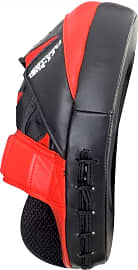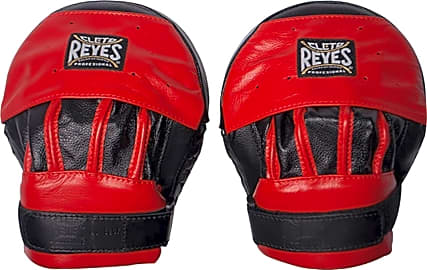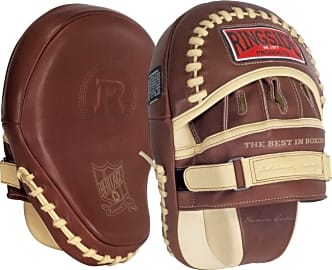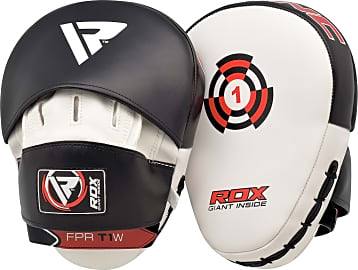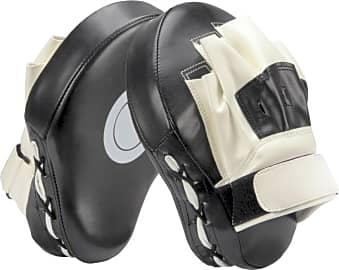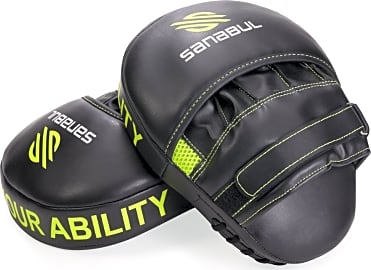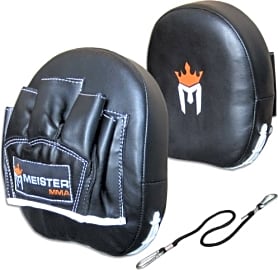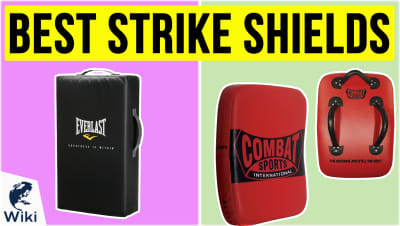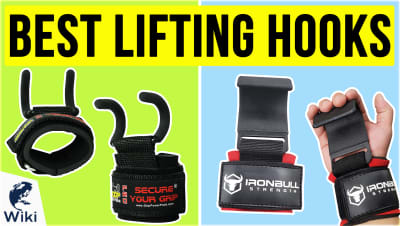The 10 Best Punch Mitts

This wiki has been updated 42 times since it was first published in September of 2015. A pretty handy piece of equipment for protecting your boxing, karate or mixed martial arts training partner, these punch mitts are tough enough to withstand regular beatings from accomplished fighters. And while they are designed for fight practice, they can also serve as an outlet for blowing off steam and releasing frustration in the form of a high-powered cardio workout. When users buy our independently chosen editorial choices, we may earn commissions to help fund the Wiki.
Editor's Notes
April 08, 2021:
We found that this list was still in good health a year later, with the lion’s share of our former choices still looking like smart selections. One exception to this was the RDS Hook & Jab FPL-T3W, which we ended up phasing out since it wasn't available. Notably, the company still holds a place on our list through the more-affordable RDX Thai Strike FPR-T1R.
We also noticed that the Ringside Heritage was missing in action at the time of this writing, but we were loathed to eliminate them because we loved their classy aesthetic. Luckily, a quick conversation with the company cleared the situation up for us, and they assured us that this option would be back in stock within a few weeks.
We added the Mexican-made Cleto Reyes Curved to our list, noticing that this was one well-recognized company that didn’t have any representation on these rankings, and we swapped out the Ringside Panther for the Ringside Pro, which, although they cost a bit more, beat out their predecessors with additional cushioning, a better-fitting design and a recessed target area that makes them easier to deal with, for both the trainer and trainee in question.
Focus pads are an amazing way to train hand-eye coordination and punch speed, but they’re widely thought to be less favorable when it comes to working kicks. When it’s time to get down to building some callouses up on your shins, you’re likely to be much better off equipping your partner with a strike shield. Or, if you’re training solo, it’s hard to go wrong with running drills on a heavy bag.
January 23, 2020:
During this round of updates, while most of our previous selections maintained their positions, we did remove the Blok-It Focus and Title Boxing Platinum, due to availability issues. In their places, we’ve included two new offerings from Fairtex, a Thai company that’s known for the toughness of their gear throughout the martial arts world.
The Fairtex Pro Angular is a teardrop-shaped model that could almost be described as a hybrid between a traditional focus mitt and a Thai pad, though that’s a bit generous. While it’s no replacement for a full-sized pad, when it comes to training kicks, at 11 inches in length it does offer some protection to your wrist. So, if you spontaneously decide to call out a head kick in the middle of a hands round, you can consider your chances of a forearm injury to be significantly reduced.
The Fairtex FMV13 is a smart-looking option with a durable microfiber shell that’s available in five colors. With four layers of foam padding, these mitts are a joy to hold, and even more fun to hit. They even have the Fairtex slogan "never give up" printed along the top edge of the pad, which is always a nice reminder when you’re having a lethargic day and thinking about giving less than 100% to your training. At 13 inches, they're even longer than the Pro Angular.
A few details to punch out before making a purchase:
Venting: Nobody’s a fan of sweaty hands, least of all when there’s a good chance that you’re passing equipment back and forth with a partner. With this in mind, you’ll likely want to consider gear that incorporates some hand-cooling considerations. While models like the Pamase Dojo and Meister MMA Target feature open-finger designs that save your fingertips from marinating in their own perspiration, the RDX Hook & Jab FPL-T3W has a wicking material in the hand pocket that works to absorb sweat. Other choices like the Ringside Heritage and RDX Thai Strike FPR-T1R have vented slots across the back of the hand, which allows a bit of fresh air to get in. Note that none of these are perfect solutions, sweaty hands are an inevitability that comes with fight training (and realistically, most cardio work outs), but the difference between a well-vented design and a stifling mitt, like the budget-friendly Sanabul Essential, is noticeable during a hard training session.
Cushioning: A good focus mitt needs to be firm and also have some give, but how much of each you want is likely going to come down to personal preference. My tendency leans toward a firmer mitt with less cushioning, as I find that it encourages speed over power and it makes it easier to catch punches. However, I’d be lying if I said I’ve never wished for an extra inch of cushion while I was holding pads for a heavy hitter. So, it’s all about balance. In order to deliver a pad that’s both firm and shock absorbent, advanced options like the RDX Hook & Jab FPL-T3W employ complex designs with three layers of gel-foam padding. The Fairtex FMV13 goes one step further than this, with a four-layer foam core.
Strapping: Again, this is going to come down to preference dictated by your circumstance. In general, a solid strap to make sure your hand is securely in place is a good idea. The problem is, tightening the strap on your second focus mitt once the first is already on your hand is virtually impossible.
So, the basic options you’re facing are having your training partner tighten your straps for you – an accepted inconvenience in serious training; keep your strap loosely fastened and slip the pad on – which still allows you the opportunity to properly tighten the first mitt you put on; or simply choose a slip-on design like the Ringside Panther – which still provides a decent fit that’s suitable for beginner-to-intermediate training (I keep a pair of these in the backyard at home, in case the need for martial-arts training spontaneously erupts during a Sunday barbecue).
If you aren’t bothered by the inconvenience that comes with strapping up before training sessions, and all that matters to you is getting the best fit possible, then you might want to consider the Ringside Heritage, which go a step beyond the standard hook-and-loop Velcro strap, incorporating a double-hook-and-loop strap that offers superior support.
A note on safety:
While many of these mitts have designs that go to great lengths to help minimize injuries, fight training, by nature, is an intrinsically dangerous pursuit that tends to, whether accidentally or intentionally, lead to physical harm, from time to time. To mitigate any risk of injury, take your training seriously, focus on form, stretch before and after sessions and remember that speed and accuracy always trump improperly channeled power.
Special Honors
Fairtex Pads While some highlight options from this Thai company have appeared on our list, they barely scratch the surface of their training gear. Offering everything from kick pads to belly pads, all equipment is hand stitched and built to a standard that's second to none. fairtex.com
Ringside Punching Bags Focus pads can be a great way to train hand-eye coordination, and a lot of fun when you're training with a partner, but when you're looking to get some solo work in, what you really need is a target that's hanging from the ceiling. Ringside offers bags from several companies through their website, and their own equipment strikes a nice balance of quality and affordability, for anybody looking to invest in their first heavy bag. ringside.com
What Separates a Good Punch Mitt From a Great One?
Consequently, any worthwhile pair of mitts should allow your fingers to either breathe or rest comfortably inside a cushioned glove.
The key to a great punch mitt is its ability to absorb a shot. This is important for the boxer, but even more so for the trainer, whose palms need to maintain their position even after a flurry of blows.
Most punching mitts feature a leather exterior which is both durable and resilient. Beneath the leather is a reinforced layer of foam padding. Top-of-the-line gloves sometimes combine that foam padding with gel, which cushions the contact while ensuring that the mitt retains its shape. Shape is important in that most mitts bend inward, complementing the curved shape of a boxer's glove. If the mitt has no cushion, that could impact a boxer's wrist. A lack of cushion could also end up fracturing a trainer's metacarpals or phalanges.
Consequently, you may want to take note of a punching mitt's weight. If a mitt weighs less than a pound, chances are you're going to experience some blowback whenever sustaining any hitter's punches. If, on the other hand, the mitt weighs more than 3 lbs., that weight could impede your ability to swing quickly whenever taking part in any slipping drills (please see below).
From a trainer's perspective, it is critical to account for the fact that you'll be sweating in these mitts for several minutes at a time. Consequently, any worthwhile pair of mitts should allow your fingers to either breathe or rest comfortably inside a cushioned glove. Be sure to read some of each mitt's customer reviews before making a final purchasing decision. This way you can get a sense of whether there might be any risk of the gloves fitting too tight, or falling apart.
Several Training Drills That Are Centered Around Punch Mitts
Punch mitts, which are also referred to as focus mitts, are beneficial because they allow a fighter to simulate hitting a precise target while simultaneously slipping any punch that could be hurtling his way. As any trainer will attest, a fighter is never more exposed than in the seconds immediately after he has thrown a fist.
The purpose of a slipping drill is to teach a boxer how to maintain balance despite turning, or crouching, or otherwise disrupting his stance.
This may explain why one of the most common focus mitt drills involves both the boxer and the trainer throwing a straight jab at the same time. The goal of this drill is for a boxer to practice sidestepping the trainer's jab, while also landing his own punch (This is usually accomplished by striking upward at an angle, from a crouching position). Once the boxer has thrown an initial jab, the trainer may insist that he follow it up with a combination to work on timing: counter-jab-cut-hook-repeat, for example, and so on.
The trainer and the boxer develop a kind of shorthand for these drills, wherein every combination is represented via a number. If the trainer calls out, "Three!" for instance, then the boxer may respond by throwing a right-hand jab followed by a left-hand cross. Each number corresponds to a pattern. Over time, this focuses the boxer's precision. As a result, the trainer might call out any one of these combinations during an actual match in the same way that an NFL quarterback might call out a well-choreographed play.
One of the best drills for practicing combinations is called "The 4 Count." The 4 Count consists of throwing four repetitive combinations (e.g., "1-6-3-9!") in rapid succession. These combinations may vary based on style, and perhaps even upcoming opponents. As the boxer establishes a rhythm, the trainer might begin to increase the tempo, or even incorporate some slipping drills to keep the boxer on his toes. The purpose of a slipping drill is to teach a boxer how to maintain balance despite turning, or crouching, or otherwise disrupting his stance. During the majority of these drills, a boxer is made to duck or swivel, as the trainer swings the focus mitts to simulate incoming blows.
How The Focus Mitt Arrived Full Circle
Punch mitts were originally designed for training martial artists, who would use these mitts to harness their power. The goal for any martial artist was to hit each mitt in its central pocket, which was painted like a bull's-eye. The more adept a fighter became at placing his punches, the more successful he could be when squaring off against any opponent.
These apparatuses had little give, and they were ineffective in terms of teaching a fighter how to respond.
These early "focus mitts" were an asset in that - up until the early 1900s - martial artists had been forced to practice blocking or punching on a wooden dummy or the blunt exterior of a Thai pad. These apparatuses had little give, and they were ineffective in terms of teaching a fighter how to respond. Sparring was beneficial, but it also increased the chances that a fighter could get hurt. Focus mitts, on the other hand, were being worn by a sensei who was working with the martial artist, as opposed to against him.
There is no landmark patent for a focus mitt, although everyone from Rocky Marciano to Bruce Lee has been credited with either inventing these mitts, or bringing them into the mainstream. What is evident is that these mitts really took off throughout professional boxing's golden era (i.e., 1950-2000), a period during which the designation "punch mitts" became more apropos.
Today, focus mitts are experiencing a commercial resurgence thanks in large part to mixed martial arts. There is an irony to this in that martial artists were the first athletes to train by using focus mitts. This was, of course, eons before the UFC came along, and transformed martial arts into a billion-dollar sport.


